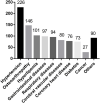Demand analysis of telenursing among empty-nest elderly individuals with chronic diseases based on the Kano model
- PMID: 36249233
- PMCID: PMC9555810
- DOI: 10.3389/fpubh.2022.990295
Demand analysis of telenursing among empty-nest elderly individuals with chronic diseases based on the Kano model
Abstract
Aim: The increase in empty-nest elderly individuals with chronic diseases poses a major challenge to the provision of public health services in China. Telenursing can effectively relieve the pressure of public health services to a certain extent. This study aims to explore the telenursing needs of empty-nest elderly individuals with chronic diseases based on the Kano model to provide references for improving the quality of telenursing.
Methods: Participants were selected from five rural communities and five urban communities in Yangzhou and Nantong, Jiangsu Province, China. A total of 348 empty-nest elderly individuals with chronic diseases were included. The participants received a sociodemographic characteristics questionnaire, and their telenursing needs were surveyed and analyzed based on the Kano model.
Results: Of the 15 quality attributes evaluated by the participants, 3 telenursing services were categorized as "must-be quality", 5 were categorized as "one-dimensional quality", 5 were categorized as "attractive quality", and 2 were categorized as "indifferent quality". The proportion of individuals who desired telenursing services ranged from 47.41 to 83.62%, the better values (satisfaction) ranged from 35.29-83.98%, and the worse values (dissatisfaction) ranged from 10.91 to 63.27%. There were no significant differences in any items of telenursing needs for between participants in Yangzhou and Nantong (all P > 0.05), and there were also no significant differences in all items between rural and urban communities (all P > 0.05).
Conclusion: Based on the Kano model, it was found that empty-nest elderly individuals with chronic diseases had a positive attitude toward telenursing and that they had different levels of need for different telenursing services. These findings provided a theoretical basis for medical decision-makers to formulate medical policies and provided a scientific foundation for nursing managers to improve telenursing services to meet the needs of the empty-nest elderly individuals with chronic diseases.
Keywords: Kano model; chronic diseases; elderly; empty-nest; telenursing.
Copyright © 2022 Yuan, Tao, Yu, Wang, Kitayama, Takashi, Yanagihara and Liang.
Conflict of interest statement
The authors declare that the research was conducted in the absence of any commercial or financial relationships that could be construed as a potential conflict of interest.
Figures
References
-
- United Nations . World Population Prospects 2022: Summary of Results. (2022). Available online at: https://desapublications.un.org/publications/world-population-prospects-...
Publication types
MeSH terms
LinkOut - more resources
Full Text Sources
Medical




